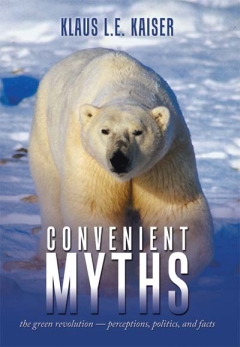|
|
CONVENIENT MYTHS
the
green revolution —
perceptions, politics, and
facts |
 |
by Klaus L.E. Kaiser, is the first clearly written, comprehensive
book looking at the green desires and expectations and juxtaposing
these with the physical and chemical facts and realities.
CONVENIENT MYTHS explains in common terms why many of these
green ideas will remain myths and dreams. The laws of nature cannot
be broken. No matter how much we may desire the opposite.
Keywords / Chapters:
|
Climate change, global warming, IPCC, government, media, propaganda, deficit, inflation, earthquakes, volcanos,
pollution, ice ages, greenhouse gases, carbon dioxide, methane, water vapor, sea ice, Arctic, polar bears, seals, whales,
energy, temperature, cod, salmon, El Nino, hurricanes, typhoons, earth, freshwater, deforestation, physics, chemistry, biology,
freshwater, aquifers, desalination, disinfection, fluoridation, air, ozone, smog, acid rain, crude oil, coal, natural gas, electric power,
electric cars, fossil fuels, natural gas, nuclear, geothermal, heat pump, wave power, osmosis, wind, solar energy, biofuels, ethanol, engine,
hybrid, hydrogen, light, food, organic, genetically modified, fish, contaminants, sun, radiation, light, X-rays,
weather, droughts, floods, diseases, longevity, cancer, Alzheimer's, malaria, progress |
|
Book Excerpts
The Earth
In terms of cosmic relevance, the planet Earth may as well not exist. It is one of the smallest planets in our solar system; for comparison, Jupiter, the largest planet
in our solar system, has 318 times the mass of Earth. The Sun itself is a tiny star in our galaxy of an estimated 200-plus billion stars. The universe, as seen from the
Hubble Telescope counts at least 80 billion galaxies, one of which is shown in the figure below.
Life on Earth is found almost exclusively within its atmosphere and its water, roughly the range of 6 km above and below sea level, a small fraction of the total volume.
For comparison, if you think of the planet as a ball the size of a tall person, 2 m in diameter, life is found only within the width of a few human hairs on either side
of its surface. If we consider the upper boundary of tree growth (about 1500 m elevation) as a practical limit of life on the landmass, then the ball model shows life
only in a razor-blade-thin layer around its surface.
The atmosphere thins quickly with height. Mountaineers climbing Mt. Everest (about 8 km height) find that water boils at 50 °C or so, due to the reduced atmospheric
pressure; even breathing there is quite difficult. Our intercontinental airplanes are typically flying at a height of about 12 km and have pressurized cabins and
oxygen supplies for the event of a sudden depressurization. Some of those planes show you the actual outside temperature at that height, usually around -60 °C
(equivalent to -76 °F). That is the temperature there all the time. Even near the equator, where the temperature at the surface is hovering around 30 °C all the
time, at an elevation of only 5,500 m, you can find perennial glaciers, for example on Mt. Kilimanjaro in Africa, on Nevado Chachani in Peru, and on Mt. Jaya on
the island of New Guinea....
Back to excerpts
|
|
| Copyright © 2010-2023, Klaus L.E. Kaiser. All Rights Reserved. |
|



